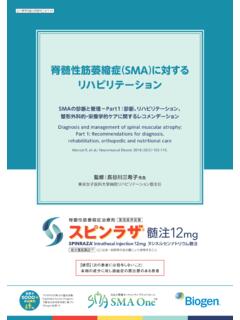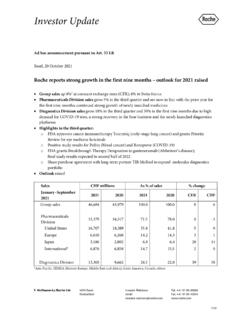Transcription of ANNEX I SUMMARY OF PRODUCT CHARACTERISTICS - …
1 ANNEX I. SUMMARY OF PRODUCT CHARACTERISTICS . 1. This medicinal PRODUCT is subject to additional monitoring. This will allow quick identification of new safety information. Healthcare professionals are asked to report any suspected adverse reactions. See section for how to report adverse reactions. 1. NAME OF THE MEDICINAL PRODUCT . Spinraza 12 mg solution for injection 2. QUALITATIVE AND QUANTITATIVE COMPOSITION. Each 5 ml vial contains nusinersen sodium equivalent to 12 mg nusinersen. Each ml contains mg of nusinersen. For the full list of excipients, see section 3. PHARMACEUTICAL FORM. Solution for injection. Clear and colourless solution with pH of approximately 4. CLINICAL PARTICULARS. Therapeutic indications Spinraza is indicated for the treatment of 5q spinal muscular atrophy . Posology and method of administration treatment with Spinraza should only be initiated by a physician with experience in the management of spinal muscular atrophy (SMA).
2 The decision to treat should be based on an individualised expert evaluation of the expected benefits of treatment for that individual, balanced against the potential risk of treatment with Spinraza. Patients with profound hypotonia and respiratory failure at birth, where Spinraza has not been studied, may not experience a clinically meaningful benefit due to severe SMN protein deficiency. Posology Spinraza is for intrathecal use by lumbar puncture. The recommended dosage is 12 mg (5 ml) per administration. Spinraza treatment should be initiated as early as possible after diagnosis with 4 loading doses on Days 0, 14, 28 and 63. A maintenance dose should be administered once every 4 months thereafter. Duration of treatment Information on long term efficacy of this medicinal PRODUCT is not available.
3 The need for continuation of therapy should be reviewed regularly and considered on an individual basis depending on the patient's clinical presentation and response to the therapy. Missed or delayed doses If a loading dose is delayed or missed Spinraza should be administered as soon as possible, with at least 14 days between doses, and continue dosing at the prescribed frequency. If a maintenance dose is 2. delayed or missed, Spinraza should be administered as soon as possible and dosing continued every 4. months. Special populations Renal impairment Spinraza has not been studied in patients with renal impairment. The safety and efficacy in patients with renal impairment has not been established and they should be closely observed. Hepatic impairment Spinraza has not been studied in patients with hepatic impairment.
4 Spinraza is not metabolised via the cytochrome P450 enzyme system in the liver, therefore dose adjustment is unlikely to be required in patients with hepatic impairment (see sections and ). Method of administration treatment should be administered by health care professionals experienced in performing lumbar punctures. Spinraza is administered as an intrathecal bolus injection over 1 to 3 minutes, using a spinal anaesthesia needle. The injection must not be administered in areas of the skin where there are signs of infection or inflammation. It is recommended that the volume of cerebral spinal fluid (CSF), equivalent to the volume of Spinraza to be injected, is removed prior to administration of Spinraza. Sedation may be required to administer Spinraza, as indicated by the clinical condition of the patient.
5 Ultrasound (or other imaging techniques) may be considered to guide intrathecal administration of Spinraza, particularly in younger patients and in patients with scoliosis. Aseptic technique should be used when preparing and administering Spinraza; see instructions for use in section Contraindications Hypersensitivity to the active substance or to any of the excipients listed in section Special warnings and precautions for use Lumbar puncture procedure There is a risk of adverse reactions occurring as part of the lumbar puncture procedure ( headache, back pain, vomiting; see section ). Potential difficulties with this route of administration may be seen in very young patients and those with scoliosis. The use of ultrasound or other imaging techniques to assist with intrathecal administration of Spinraza, can be considered at the physician's discretion.
6 Thrombocytopenia and coagulation abnormalities Thrombocytopenia and coagulation abnormalities, including acute severe thrombocytopenia, have been observed after administration of other subcutaneously or intravenously administered antisense oligonucleotides. If clinically indicated, platelet and coagulation laboratory testing is recommended prior to administration of Spinraza. Renal toxicity Renal toxicity has been observed after administration of other subcutaneously and intravenously administered antisense oligonucleotides. If clinically indicated, urine protein testing (preferably using a first morning urine specimen) is recommended. For persistent elevated urinary protein, further evaluation should be considered. 3. Hydrocephalus There have been reports of communicating hydrocephalus not related to meningitis or bleeding in patients treated with nusinersen in the post-marketing setting.
7 Some patients were implanted with a ventriculo-peritoneal shunt. In patients with decreased consciousness, an evaluation for hydrocephalus should be considered. The benefits-and risks of nusinersen treatment in patients with a ventriculo- peritoneal shunt are unknown at present and the maintenance of treatment needs to be carefully considered. Interaction with other medicinal products and other forms of interaction No interaction studies have been performed. In vitro studies indicated that nusinersen is not an inducer or inhibitor of CYP450 mediated metabolism. In vitro studies indicate that the likelihood for interactions with nusinersen due to competition for plasma protein binding, or competition with or inhibition of transporters is low. Fertility, pregnancy and lactation Pregnancy There are no or limited amount of data from the use of nusinersen in pregnant women.
8 Animal studies do not indicate direct or indirect harmful effects with respect to reproductive toxicity (see section ). As a precautionary measure, it is preferable to avoid the use of Spinraza during pregnancy. Breast-feeding It is unknown whether nusinersen/metabolites are excreted in human milk. A risk to the newborn/infants cannot be excluded. A decision must be made whether to discontinue breast-feeding or to discontinue/abstain from Spinraza therapy taking into account the benefit of breast-feeding for the child and the benefit of therapy for the woman. Fertility In toxicity studies in animals no effects on male or female fertility were observed (see section ). There are no data available on the potential effects on fertility in humans. Effects on ability to drive and use machines Spinraza has no or negligible influence on the ability to drive and use machines.
9 Undesirable effects SUMMARY of safety profile The safety assessment of Spinraza was based on two Phase 3 clinical studies in infants (CS3B) and children (CS4) with SMA, together with one Phase 2 study in infants and children with SMA (CS7). and open-label studies including pre-symptomatic infants (CS5) genetically diagnosed with SMA and infants and children with SMA. Study CS11 enrolled infantile and later-onset patients including those who had completed studies CS3B, CS4 and CS12. Of the 346 patients who received Spinraza up to a maximum of 5 years, 258 patients received treatment for at least 1 year. Tabulated list of adverse reactions The assessment of undesirable effects is based on the following frequency data: Very common ( 1/10). Not known (cannot be estimated from the available data).
10 4. Table 1: Adverse reactions related to lumbar puncture procedure reported in CS4 (later onset SMA). with an incidence at least 5% higher in patients treated with Spinraza than sham-control MedDRA System Organ Class MedDRA preferred term Spinraza frequency category, n=84. Nervous system disorders Headache* Very common Gastrointestinal disorders Vomiting* Very common Musculoskeletal and connective Back pain* Very common tissue disorders *. Adverse events considered related to the lumbar puncture procedure. These events can be considered manifestations of post-lumbar puncture syndrome. Post-marketing experience Adverse reactions have been identified during post-approval use of Spinraza. Among patients treated with Spinraza by lumbar puncture, serious infection, such as meningitis, has been observed.











